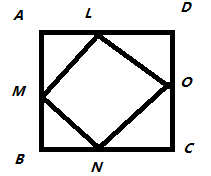Ask questions which are clear, concise and easy to understand.
Ask QuestionPosted by Shivam Giri 3 years ago
- 1 answers
Posted by Mukesh Singh 3 years ago
- 3 answers
Sambit Kumar Das 3 years ago
Posted by Mohak Dubey 3 years ago
- 2 answers
Posted by Riya Kumari 3 years ago
- 0 answers
Posted by Vaishnav Ravikumar 3 years ago
- 3 answers
Posted by Nilanjna Singh 3 years ago
- 2 answers
Preeti Dabral 3 years ago
Given: ABCD is a square, where {tex}\angle{/tex}PQR = 90o and PB = QC = DR
To prove: (i) QB = RC (ii) PQ = QR
(iii) {tex}\angle{/tex}QPR = 45o
Proof:
- Here,
BC = CD … (Sides of square)
CQ = DR … (Given)
BC = BQ + CQ
{tex}\therefore{/tex} CQ = BC − BQ
{tex}\therefore{/tex} DR = BC – BQ .......(1)
Also,
CD = RC + DR
{tex}\therefore{/tex} DR = CD - RC = BC - RC ........(2)
From (1) and (2), we have,
BC - BQ = BC - RC
{tex}\therefore{/tex} BQ = RC - Now in {tex}\triangle{/tex}RCQ and {tex}\triangle{/tex}QBP
we have, PB = QC … (Given)
BQ = RC … [from (i)]
{tex}\angle{/tex}RCQ = {tex}\angle{/tex}QBP … 90o each
Hence by SAS(Side-Angle-Side) congruence rule,
{tex}\triangle{/tex}RCQ {tex}\cong{/tex} {tex}\triangle{/tex}QBP
{tex}\therefore{/tex} QR = PQ … (by cpct) - {tex}\triangle{/tex}RCQ {tex}\cong{/tex} {tex}\triangle{/tex}QBP and QR = PQ … [from (2)]
{tex}\therefore{/tex} In {tex}\triangle{/tex}RPQ,
{tex}\angle{/tex}QPR = {tex}\angle{/tex}QRP ={tex}\frac{1}{2}{/tex}(180o - 90o) = {tex}\frac{90}{2}{/tex}= 45o
{tex}\therefore{/tex} {tex}\angle{/tex}QPR = 45o
Posted by Hena Kausar 3 years ago
- 0 answers
Posted by Jinali Zaveri 3 years ago
- 1 answers
Preeti Dabral 3 years ago

Given: In right triangle ABC, right angled at C. M is the mid-point of hypotenuse AB. C is joined to M and produced to a point D such that DM = CM. Point D is joined to point B.
To Prove:
- {tex}\triangle{/tex}AMC {tex}\cong{/tex} {tex}\triangle{/tex}BMD
- {tex}\angle{/tex}DBC is a right angle
- {tex}\triangle{/tex}DBC {tex}\cong{/tex} {tex}\triangle{/tex}ACB
- CM = {tex}\frac {1} {2}{/tex}AB
Proof:
- In {tex}\triangle{/tex}AMC and {tex}\triangle{/tex}BMD
AM = BM ...[As M is the mid-point]
CM = DM ...[Given]
{tex}\angle{/tex}AMC = {tex}\angle{/tex}BMD ...[Vertically opposite angles]
{tex}\therefore{/tex} {tex}\triangle{/tex}AMC {tex}\cong{/tex} {tex}\triangle{/tex}BMD proved ...[SAS property] ...(1) - {tex}\triangle{/tex}AMC {tex}\cong{/tex} {tex}\triangle{/tex}BMD ...[From (1)]
{tex}\angle{/tex}ACM = {tex}\angle{/tex}BDM ...[c.p.c.t.]
These are alternate interior angles and they are equal.
{tex}\therefore{/tex} AC {tex}\|{/tex} BD
As AC {tex}\|{/tex} BD and transversal BC intersects them
{tex}\therefore{/tex} {tex}\angle{/tex}DBC + {tex}\angle{/tex}ACB = 180° ...[Sum of the consecutive interior angles of the transversal]
{tex}\angle{/tex}DBC + 90° = 180°
{tex}\angle{/tex}DBC = 180° - 90° = 90°
{tex}\angle{/tex}DBC is a right angle proved. - {tex}\triangle{/tex}AMC {tex}\cong{/tex} {tex}\triangle{/tex}BMD ...[From (1)]
{tex}\therefore{/tex} AC = BD ...[c.p.c.t.] ...(2)
In DDBC and DACB
BC = CB ...[Common]
{tex}\angle{/tex}DBC = {tex}\angle{/tex}ACB ...[each = 90° as proved above]
BD = CA ...[From (2)]
{tex}\therefore{/tex} {tex}\triangle{/tex}DBC {tex}\cong{/tex} {tex}\triangle{/tex}ACB ...[SAS property] - DDBC {tex}\cong{/tex} DACB ...[As proved in (iii)]
{tex}\therefore{/tex} DC = AB ...[c.p.c.t.]
{tex}\therefore{/tex} 2CM = AB ...[DM = CM = {tex}\frac {1} {2}{/tex} DC]
{tex}\therefore{/tex} CM ={tex}\frac {1} {2}{/tex} AB
Posted by Sonali Verma 3 years ago
- 1 answers
Preeti Dabral 3 years ago

Let a square ABCD in which L, M, N & O are the midpoints.
In {tex}\triangle{/tex}AML and {tex}\triangle{/tex}CNO
AM = CO (AB = DC and M and O are the midpoints)
AL = CN (AD = BC and L and N are the midpoints)
{tex}\angle{/tex} MAL = {tex}\angle{/tex}NCO (all angles of a square = 90°)
by AAS criteria
{tex}\triangle{/tex}AML {tex}\cong{/tex} {tex}\triangle{/tex}CNO
{tex}\therefore{/tex} ML = ON (CPCT)
similarly {tex}\triangle{/tex}MBN {tex}\cong{/tex} {tex}\triangle{/tex}LDO
now,
in {tex}\triangle{/tex}AML,
{tex}\angle{/tex}AML = {tex}\angle{/tex}ALM (AM = AL)
= 45°
similarly in {tex}\triangle{/tex}LDO
{tex}\angle{/tex}DLO = 45°
{tex}\therefore{/tex} {tex}\angle{/tex} MLO = 90°
by the properties of SQUARE
All sides are equal and angles are 90°
Posted by Harshdeep Raj 3 years ago
- 1 answers
Posted by Allpesha Shambharkar 3 years ago
- 2 answers
Preeti Dabral 3 years ago
Factor Theorem is generally applied to factoring and finding the roots of polynomial equations. It is the reverse form of the remainder theorem. Problems are solved based on the application of synthetic division and then to check for a zero remainder.
Posted by Nandini.M ......... 3 years, 1 month ago
- 2 answers
Posted by Harsimran Kaur 3 years, 1 month ago
- 3 answers
Posted by Shravan Namdeowar 3 years, 1 month ago
- 0 answers
Posted by Jeel Patel 3 years, 1 month ago
- 4 answers
Aditya Yadav 3 years, 1 month ago
Posted by Durga Morya 3 years, 1 month ago
- 1 answers
Suprabha Barik 3 years, 1 month ago
Posted by Sandeep Singh 3 years, 1 month ago
- 1 answers
Posted by Neha Srinitya Banoth 3 years, 1 month ago
- 1 answers
Aditya Yadav 3 years, 1 month ago
Posted by Nupur Saraswat 3 years, 1 month ago
- 1 answers
Posted by Kavin M 3 years, 1 month ago
- 2 answers
Sheetal Gupta 3 years ago
Posted by Ishta Mahour 3 years, 1 month ago
- 1 answers

myCBSEguide
Trusted by 1 Crore+ Students

Test Generator
Create papers online. It's FREE.

CUET Mock Tests
75,000+ questions to practice only on myCBSEguide app
 myCBSEguide
myCBSEguide